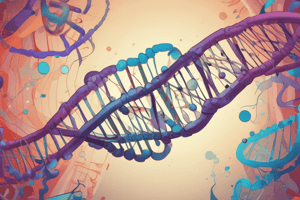Podcast
Questions and Answers
What is the basic unit of DNA?
What is the basic unit of DNA?
- Nucleotide (correct)
- Gene
- Allele
- Chromosome
Which pairing of nitrogenous bases is correct in DNA structure?
Which pairing of nitrogenous bases is correct in DNA structure?
- A with T (correct)
- G with T
- A with C
- C with A
What term describes the observable physical characteristics of an organism?
What term describes the observable physical characteristics of an organism?
- Phenotype (correct)
- Genotype
- Chromotype
- Allele expression
What defines a homozygous genotype?
What defines a homozygous genotype?
How many chromosomes are present in human cells?
How many chromosomes are present in human cells?
Which of the following correctly describes recessive alleles?
Which of the following correctly describes recessive alleles?
What primarily determines the genetic makeup of an organism?
What primarily determines the genetic makeup of an organism?
Which of the following represents a heterozygous genotype?
Which of the following represents a heterozygous genotype?
What is the expected phenotypic ratio of offspring in a monohybrid cross between two heterozygous plants (Rr x Rr)?
What is the expected phenotypic ratio of offspring in a monohybrid cross between two heterozygous plants (Rr x Rr)?
Which law states that alleles for different traits assort independently during gamete formation?
Which law states that alleles for different traits assort independently during gamete formation?
What type of inheritance pattern is illustrated by a trait that requires two recessive alleles to be expressed?
What type of inheritance pattern is illustrated by a trait that requires two recessive alleles to be expressed?
What is a classic example of X-linked recessive inheritance?
What is a classic example of X-linked recessive inheritance?
What process contributes to genetic variation by producing gametes?
What process contributes to genetic variation by producing gametes?
Which of the following is a significant application of genetics in agriculture?
Which of the following is a significant application of genetics in agriculture?
What is one primary outcome of understanding genetics in medicine?
What is one primary outcome of understanding genetics in medicine?
Which of the following factors can lead to genetic variation?
Which of the following factors can lead to genetic variation?
Flashcards are hidden until you start studying
Study Notes
Genetics Overview
- Genetics explores heredity and the transmission of characteristics from parents to offspring.
- Essential for fields like medicine, agriculture, and biotechnology.
DNA Structure
- DNA (deoxyribonucleic acid) is a double helix made of two strands.
- Basic unit: nucleotide, consisting of:
- Phosphate group
- Deoxyribose sugar
- Nitrogenous base (A, T, C, G)
- Sequence of nitrogenous bases encodes genetic information; complementary base pairing (A-T, C-G) is vital for replication.
Genes and Chromosomes
- A gene is a nucleotide sequence that codes for proteins or functional RNA.
- Chromosomes are thread-like structures in eukaryotic cell nuclei, humans have 46 (23 pairs), inherited equally from both parents.
Alleles and Genotypes
- Alleles are different forms of a gene leading to varied phenotypic effects.
- Genotypes refer to the specific alleles possessed by an organism.
- Types of genotypes:
- Homozygous: Two identical alleles (e.g., RR, rr).
- Heterozygous: Two different alleles (e.g., Rr).
Phenotypes and Phenotypic Ratios
- Phenotype represents observable traits influenced by genotype and environment.
- Dominance governs phenotypic expression:
- Dominant alleles mask recessive alleles (e.g., Rr shows red).
- Recessive alleles are expressed only with two copies (e.g., rr is white).
- In a monohybrid cross (Rr x Rr), the expected phenotypic ratio is 3:1 (dominant to recessive).
Mendel's Laws of Inheritance
- Law of Segregation: Alleles segregate during gamete formation, each gamete has one allele per trait.
- Law of Independent Assortment: Alleles for different traits assort independently during gamete formation.
Inheritance Patterns
- Dominant Inheritance: Traits expressed with one dominant allele (e.g., Huntington's disease).
- Recessive Inheritance: Traits expressed with two recessive alleles (e.g., cystic fibrosis).
- X-Linked Inheritance: Traits on the X chromosome often affect males more (e.g., hemophilia).
Genetic Variation
- Results from mutations, gene flow, and sexual reproduction:
- Mutations: Changes in DNA can create new alleles.
- Gene Flow: Movement of genes enhances diversity in populations.
- Sexual Reproduction: Introduces variation through meiosis and fertilization.
Applications of Genetics
- Medicine: Facilitates diagnosis and treatment of genetic disorders.
- Agriculture: Involves selective breeding to improve crops and livestock traits.
- Gene Therapy: Techniques developed to correct defective genes for genetic disorder treatment.
Conclusion
- Genetics provides insights into biological processes of life, promoting advances in health and agriculture.
Studying That Suits You
Use AI to generate personalized quizzes and flashcards to suit your learning preferences.




